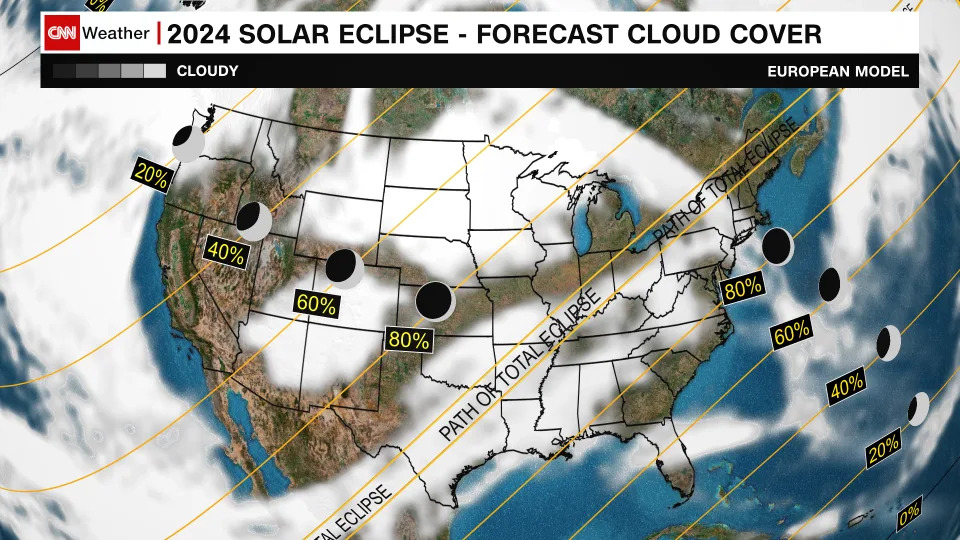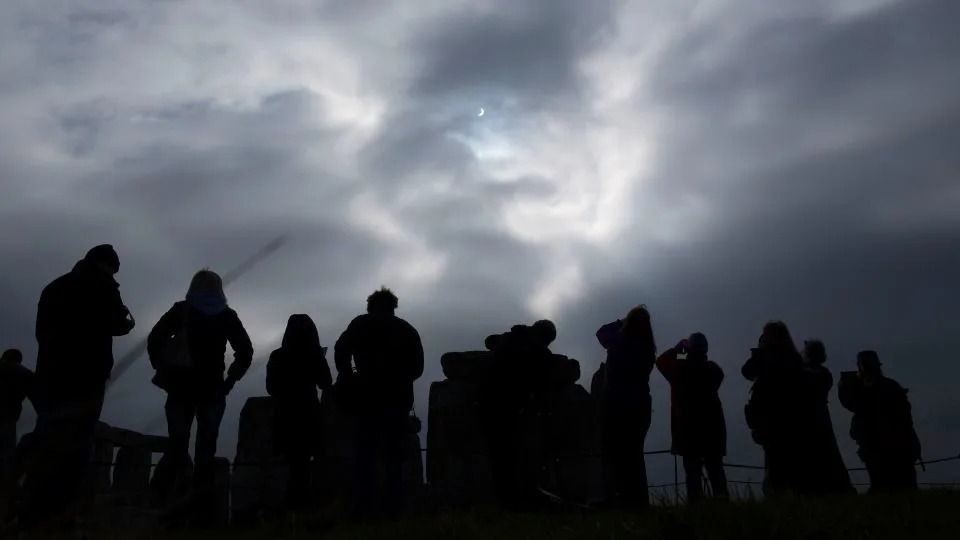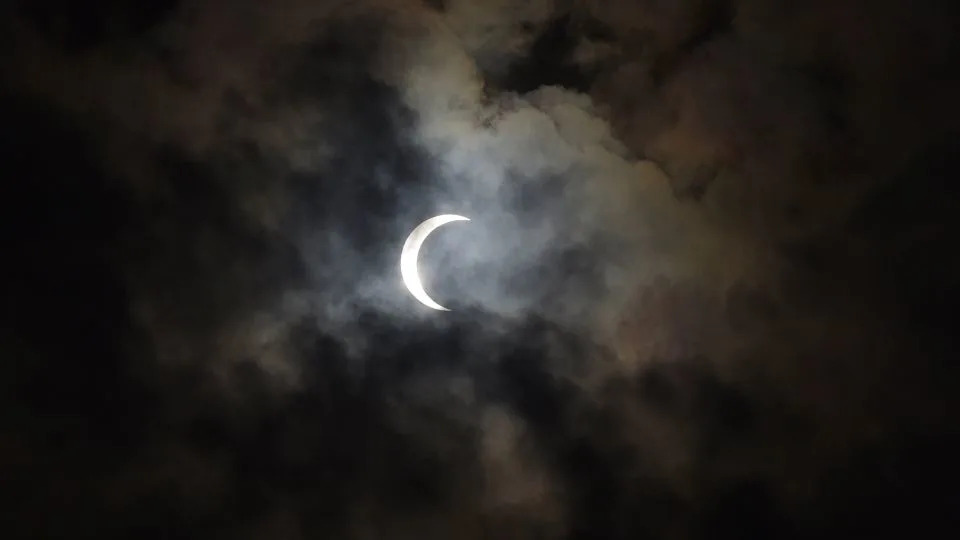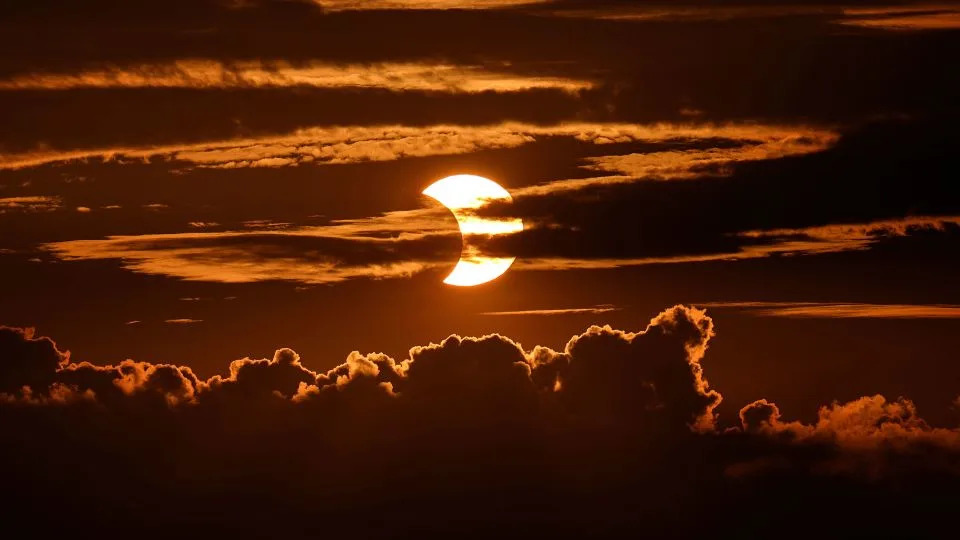The total solar eclipse is just days away and the cloud forecast is looking grim for some regions.
Aside from New England, patches of completely clear skies will be few and far between in the path of totality as a storm system tracks through the central US and moist air streams into parts of the South and East. Parts of the West, Great Lakes and Southeast coast may also luck out for a clear view of a partial eclipse.
If the clouds obscure the sky so much that you can’t see the sun through your eclipse glasses, you might not be able to see some special moments unfold from the ground.
But a cloudy forecast doesn’t mean your experience will be totally ruined – not all cloudy skies are created equal.
A forecast model depicts where clouds could be during the eclipse Monday afternoon. This forecast could shift slightly over the weekend as new weather information becomes available. - CNN Weather
There are different types of clouds which obscure more or less of the sun and fill more or less of the sky to varying extents. So exactly what combination you have will change your eclipse watching experience.
And don’t worry; whether you’re in the path of totality or just in line for a partial eclipse, you’ll still be able to experience some interesting phenomena, even under the worst-case cloud scenario.
Here’s what you might see through various levels of cloud cover.
Overcast, low-level clouds
Imagine a dreary day, when everything looks gray and gloomy. Thick clouds hover close to the ground. In a city, they may even obscure the tops of skyscrapers. The clouds make it impossible to see the sun directly, but it’s still daylight.
This type of cloudy weather is bad news for people in the path of totality hoping to get a look eclipse phenomena like Baily’s beads or the corona, but all hope for a memorable experience is not lost.
A small gap in a layer of overcast clouds allows visitors view a solar eclipse from Stonehenge in southern England on March 20, 2015. - Kieran Doherty/Reuters
For the few minutes during totality when the moon passes in front of the sun and blocks sunlight, it’ll be like a switch flipped from day to night.
Everything will go dark, temperatures will dip and any light breeze may turn calm. This experience is universal, no matter your skies.
Sunlight will dim and changes in the weather will also occur in partial eclipse areas, but to a lesser extent.
Where skies like these could happen Monday: Portions of states that border the Gulf of Mexico – especially coastal areas from Texas to Mississippi
Broken, low to mid-level clouds
A broken sky has thin strips of clear blue peeking through abundant clouds. Broken clouds don’t form a uniform layer across the sky; they can be thinner in spots and thicker in others.
Skies like these can change from one moment to the next. Patches of thicker and thinner cloud cover could take turns moving overhead during the duration of the eclipse, so there’s hope for some clearing compared to an overcast sky.
A broken layer of clouds passes below a solar eclipse in Mumbai, India, on December 26, 2019. - Vijayanand Gupta/Hindustan Times/Getty Images
Any thinner clouds or gaps in clouds will allow for a better chance to sneak a glimpse at the sun. If the gaps align just right, slightly distorted glimpses of the moon crossing in front of the sun are possible, but glimpses of the more coveted phenomena are unlikely, according to NASA.
The sky will also grow quite dark during totality and may turn different, sunset-like colors immediately before and after.
Where skies like these could happen Monday: Areas from the Southern Plains to the mid-Atlantic and much of the north-central US
Thin, high-level clouds
High level clouds are thin and wispy and can cover much of the sky but still let plenty of light through.
People under high clouds in the path of totality may still have a chance to observe coveted phenomena like the corona or any prominences. The eclipse will be visible, but blurred slightly behind a layer of thin clouds.
High-level clouds are seen at the top of the image as a partial solar eclipse unfolds behind clouds, Thursday, June 10, 2021, in Arbutus, Maryland. - Julio Cortez/AP
Under clear conditions, once the darkness of totality arrives people are able to see bright planets and stars like they would on a clear night, but high clouds make it difficult to pick out any of these celestial objects.
A partial eclipse experience with high-level clouds will be largely unobstructed, allowing for a sight of the moon blocking out a significant portion of the sun.
Where skies like these could happen Monday: A significant portion of the central and eastern US
For more CNN news and newsletters create an account at CNN.com

 German (DE)
German (DE)  English (US)
English (US)  Spanish (ES)
Spanish (ES)  French (FR)
French (FR)  Hindi (IN)
Hindi (IN)  Italian (IT)
Italian (IT)  Russian (RU)
Russian (RU)  3 weeks ago
3 weeks ago




























Comments